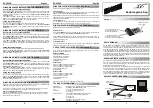
238 Administering advanced zoning
Hardware-enforced zoning
Hardware-enforced zoning means that each frame is checked by hardware (the ASIC) before it is delivered
to a zone member and is discarded if there is a zone mismatch. When hardware-enforced zoning is
active, the Fabric OS switch monitors the communications and blocks any frames that do not comply with
the effective zone configuration. The switch performs this blocking at the transmit side of the port on which
the destination device is located.
Hardware-enforced zoning is in effect when all of the members of a zone are identified the same way,
either using WWNs or
domain,port
notation.
If a zone does not have either all WWN or all
domain,port
entries, software-enforced zoning is in effect.
For overlapping zones (in which zone members appear in two or more zones), hardware-enforced zoning
is in effect as long as the overlapping zones have either all WWN or all
domain,port
entries.
Hardware-enforced zoning:
•
Is also called
hard zoning
or
ASIC-enforced zoning.
•
Prevents a host from discovering unauthorized target devices.
•
Prevents a host from accessing a device it is not authorized to access.
•
Is enforced at the ASIC level. Each ASIC maintains a list of source port IDs that have permission to
access any of the ports on that ASIC.
•
Is available on 1, 2, 4, and 10 Gb/s platforms.
•
Ensures that the name server does not return any information to an unauthorized initiator in response to
a name server query.
•
Is exclusively enforced through selective information presented to end nodes through the fabric Simple
Name Server (SNS). When an initiator queries the name server for accessible devices in the fabric, the
name server returns only those devices that are in the same zone as the initiator. Devices that are not
part of the zone are not returned as accessible devices.
Fabric OS uses hardware-enforced zoning (for each zone) whenever the fabric membership or zone
configuration changes.
The exact zoning methodology varies on different switch models.
Table 59
shows various Fabric OS switch
models, the hardware zoning methodology for each, and tips for best usage.
Содержание A7533A - Brocade 4Gb SAN Switch Base
Страница 1: ...HP StorageWorks Fabric OS 6 2 administrator guide Part number 5697 0016 Edition May 2009 ...
Страница 24: ...24 ...
Страница 99: ...Fabric OS 6 2 administrator guide 99 ...
Страница 100: ...100 Managing user accounts ...
Страница 118: ...116 Configuring standard security features ...
Страница 164: ...162 Configuring advanced security features ...
Страница 234: ...232 Installing and maintaining firmware ...
Страница 268: ...266 Administering advanced zoning ...
Страница 284: ...282 Configuring Enterprise class platforms ...
Страница 292: ...290 Routing traffic ...
Страница 294: ...292 Interoperability for merged SANs ...
Страница 302: ...300 Configuring the Distributed Management Server ...
Страница 334: ...332 iSCSI gateway service ...
Страница 340: ...338 Administering NPIV ...
Страница 407: ...Fabric OS 6 2 administrator guide 405 ...
Страница 408: ...406 Using the FC FC routing service ...
Страница 438: ...434 Administering extended fabrics ...
Страница 460: ...456 Administering ISL trunking ...
Страница 498: ...494 Configuring and monitoring FCIP extension services 556200 Bps 30s avg 491394 Bps lifetime avg ...
Страница 516: ...512 FICON fabrics ...
Страница 526: ...522 Configuring and monitoring FICON Extension Services ...
Страница 540: ...536 Configuring the PID format ...
Страница 544: ...540 Understanding legacy password behavior ...
Страница 546: ...542 Mixed fabric configurations for non merge SANs ...
Страница 550: ...546 Migrating from an MP Router to a 400 MP Router ...
Страница 558: ...554 Inband Management ...
Страница 572: ...568 ...
















































